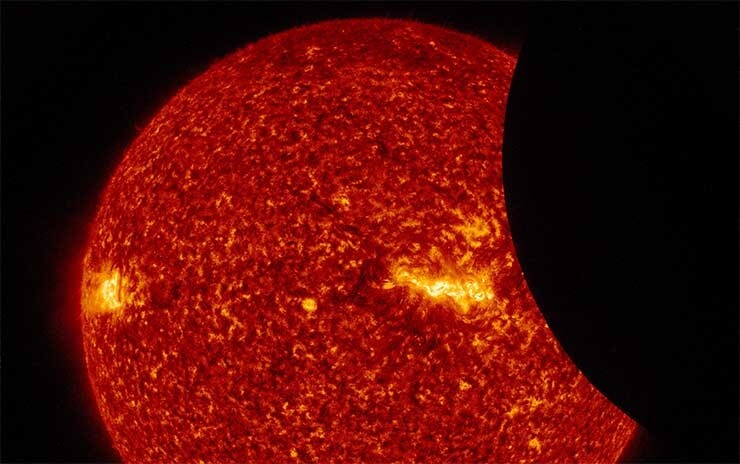
NASA’s Solar Dynamics Observatory, which launched in 2010, observed a partial eclipse of the sun on Aug. 21, 2017, while observers on the ground experienced a total eclipse.
(Image credit – NASA)

NASA’s Solar Dynamics Observatory, which launched in 2010, observed a partial eclipse of the sun on Aug. 21, 2017, while observers on the ground experienced a total eclipse.
(Image credit – NASA)
The House Science Committee held a joint subcommittee hearing
Eclipses have been studied for centuries and there are scientists who study the sun every day. NASA’s Heliophysics Division — which studies the sun and its effects on Earth and space — currently has 18 missions comprising 28 spacecraft in continual operation. Nevertheless, the eclipse represented an exciting research opportunity, even for experienced hands.
Thomas Zurbuchen, the head of NASA’s Science Mission Directorate, reported in his opening statement that NASA had 11 space-based assets and three additional aircraft observing the eclipse. He also showed a video of a research flight that he participated in during the eclipse, on which he remarked that he had never actually witnessed a total eclipse in person even though he had been working in heliophysics for 25 years.
Jim Ulvestad, the acting head of NSF’s Mathematical and Physical Sciences Directorate, said that the NSF-supported High Altitude Observatory at the National Center for Atmospheric Research designed and flew an instrument during the eclipse called the Airborne Infrared Spectrometer, which probed the magnetic environment of the sun’s corona. He also pointed to the efforts of a research team at Predictive Science, Inc. to forecast the state of the corona during the eclipse using NSF-funded supercomputers at the University of Texas and the San Diego Supercomputer Center.
Heidi Hammel, executive vice president of the Association of Universities for Research in Astronomy, a consortium that manages the National Solar Observatory (NSO), emphasized that eclipses present especially important opportunities to study the corona. She also pointed out that understanding the corona is important for understanding solar storms and space weather.
Hammel and other witnesses testified that the Daniel K. Inouye Solar Telescope, which NSO is currently constructing in Hawaii, will be equipped with a coronagraph, which will enable observations similar to those made possible by an eclipse. Zurbuchen also highlighted research that will be conducted with NASA’s Parker Solar Probe, a $1.5 billion mission scheduled for launch next year that will fly directly into the solar atmosphere.
Discussion of the sun’s corona also provided hearing participants with the opportunity to discuss space weather hazards.
In her opening remarks, Hammel pointed to the 1859 Carrington Event, a solar storm that caused widespread damage to telegraph systems, as a warning about the much more extensive destruction that could be caused today. She said,
It’s sobering to imagine the catastrophic social and economic disruption of a Carrington-like storm on today’s infrastructure, including GPS satellites, electricity grids, and communications satellites. And that is why understanding the sun and space weather are critical national imperatives.
Hammel replied that one model suggests there is a 10 percent probability every decade, that there have recently been “very large-scale solar flares” that were not directed at Earth, and that less severe events have already occurred on Earth. “So, it’s real,” she said. “It’s going to happen sooner or later, so it’s important that we are prepared for that.”
Hammel said that a number of agencies are engaged in space weather preparations. Ulvestad elaborated, pointing to the work of the Space Weather Operations Research and Mitigation Task Force of the National Science and Technology Council, and particularly the National Space Weather Action Plan
Rep. Bill Foster (D-IL), a former Fermilab physicist, later asked about how similar preparation and mitigation are for space weather events and electromagnetic pulses (EMPs) caused by nuclear weapons. Zurbuchen replied that the physics of the events is similar but that a key difference is scale, with the effects of space weather events being more widespread.
In May, the Senate passed the “Space Weather Research and Forecasting Act,”
Aside from heliophysics, the other principal subject of the hearing was the public outreach efforts surrounding the eclipse.
Matt Penn, an NSO astronomer, discussed a project he organized called the Citizen Continental-America Telescopic Eclipse (Citizen CATE) experiment. Using private, corporate, and NSF funding, the project assembled 270 volunteers, including 117 students, into 68 teams, and provided them with equipment and training. Spread out along the path of totality, the teams gathered research-quality data on the inner corona. During her opening statement, Hammel showed a video showcasing one Citizen CATE team from a school on a Native American reservation in Montana.
Michelle Nichols-Yehling, director of public observing at the Adler Planetarium in Chicago, recounted Adler’s three years of preparations for the eclipse and the various eclipse-viewing events it aided around Illinois. She said the priorities had been to increase the capacity of sites to accommodate the events, increase people’s awareness of the events, provide viewing glasses and trusted information about how to view the eclipse, and reach out to underserved audiences.
The witnesses also pointed to the efforts of NSF, NASA, and the American Astronomical Society to provide reliable scientific information and guidance on what viewing glasses are safe to use. Ulvestad said that in the future such efforts should move beyond setting up web pages to more actively pushing the information out to the public.
In general, all the participants at the hearing were highly satisfied with the enormous public interest in the eclipse. Zurbuchen noted that the 90 million page views that NASA’s website experienced on the day of the eclipse shattered its previous record. Nevertheless, everyone agreed that lessons learned from the experience would go toward making preparations for the 2024 total eclipse smoother and making the experience even better.